African Chicken Peanut Stew (Plasas)
This post may contain affiliate links. See my disclosure policy.
Simple ingredients come together to create this wonderfully flavorful African Chicken Peanut Stew. It’s a perfect example of West African comfort food at its very best!
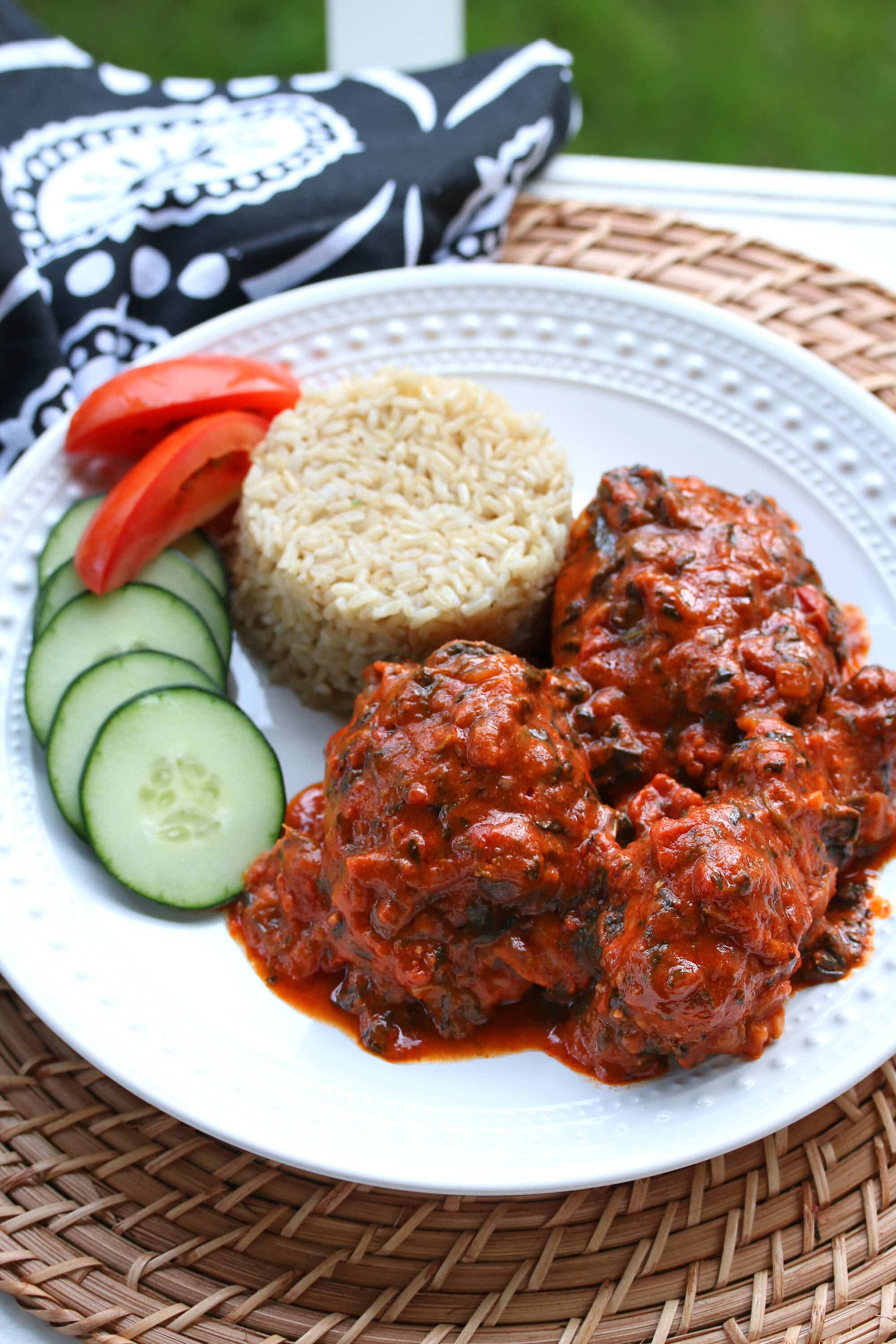
It’s been over 20 years since my friend, Bobson, first made this dish for me in Germany. A refugee from war-torn Sierra Leone, Bobson was a young man in his late 20’s trying to make a new life for himself. He had never gone to school or learned how to read but he possessed a depth of wisdom that drew respect from those who knew him. Friendly and out-going with a winning smile and a great sense of humor, Bobson was also kind-hearted and generous with what little he had.
He invited me and a couple of friends over for a traditional dish from Sierra Leone. After the first bite I was hooked. He served it with something he called pounded yam (aka “fufu”), a thick, starchy neutral-tasting substance that’s ground and then reconstituted with water. You pull off a wad of it and make an indentation with your thumb to serve as an eating utensil to scoop up the food and mop up sauce.
The next time he invited us for dinner the unanimous request was that he make that same dish. This time I watched him make it. And that’s the dish I’m sharing with you today: Bobson’s version of Sierra Leonean plasas.
What is African Chicken Peanut Stew?
This dish is popular throughout West Africa including Ghana and Sierra Leone. It’s known as plasas or sometimes also called palava sauce or palaver sauce. It doesn’t refer to a specific recipe so much as a specific kind of dish: Plasas is a sauce comprised of some type of greens (either spinach, collard greens, kale, etc), some kind of meat, peanut butter for flavor and thickening, and often dried fish. It’s commonly served with some kind of starchy side dish.
Simple ingredients come together to produce a BIG flavor in this delicious saucy stew. Chicken, peanuts, tomatoes, greens and seasonings are showcased in this winning dish that will leave you licking your fingers. A wonderfully satisfying meal, this African Chicken Peanut Stew is a perfect example of West African comfort food at its best!
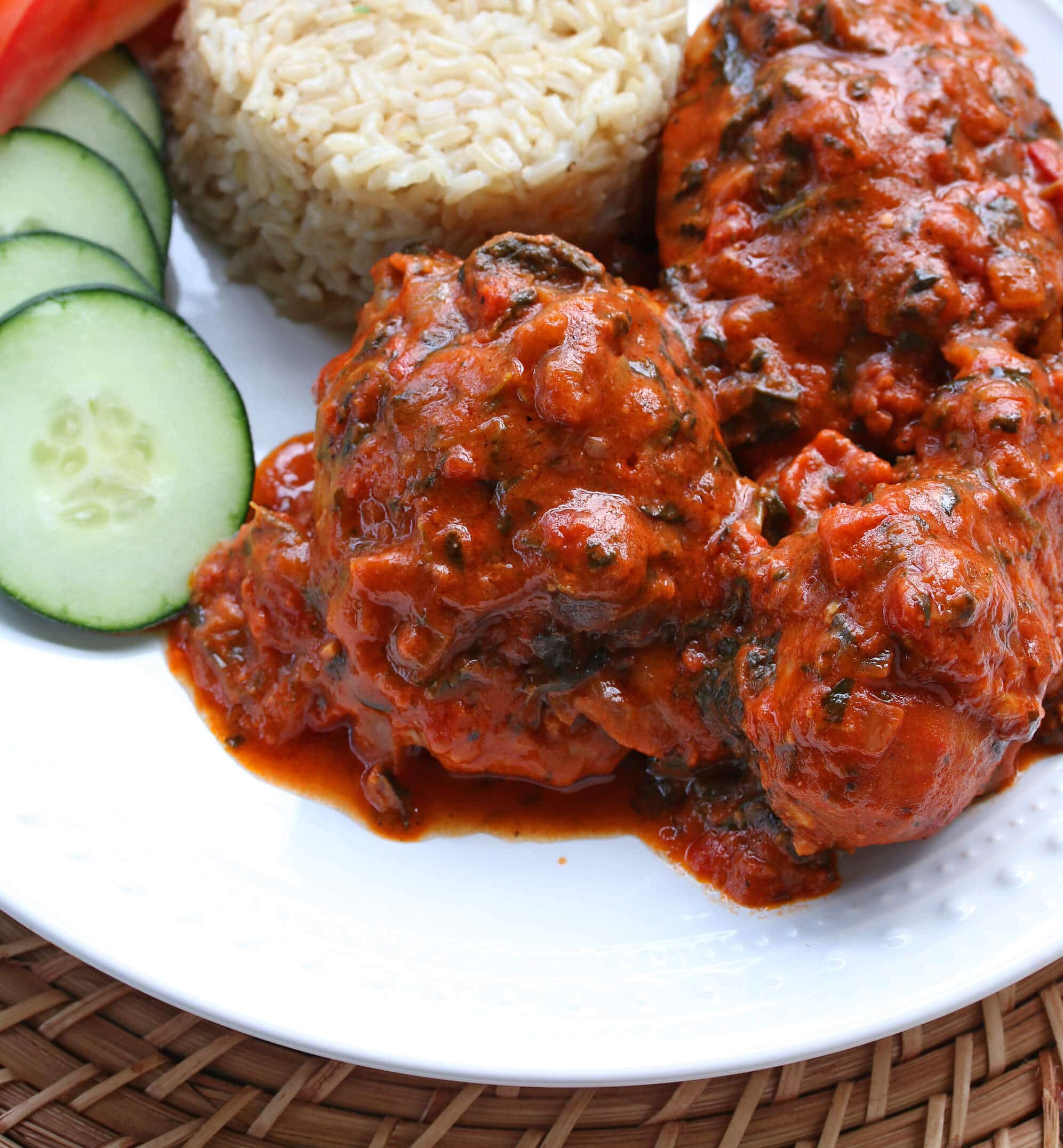
African Chicken Peanut Stew Recipe
Let’s get started!
Heat some oil in a heavy pot or Dutch oven until very hot. Generously brown the chicken pieces on all sides. Remove the chicken. In the same pot cook the onions until caramelized. Add all remaining ingredients.

Bring the sauce to a simmer and stir until the peanut butter is fully incorporated. Add the chicken pieces, nestling them in the sauce. Cover and simmer for at least an hour. Add salt and pepper to taste.
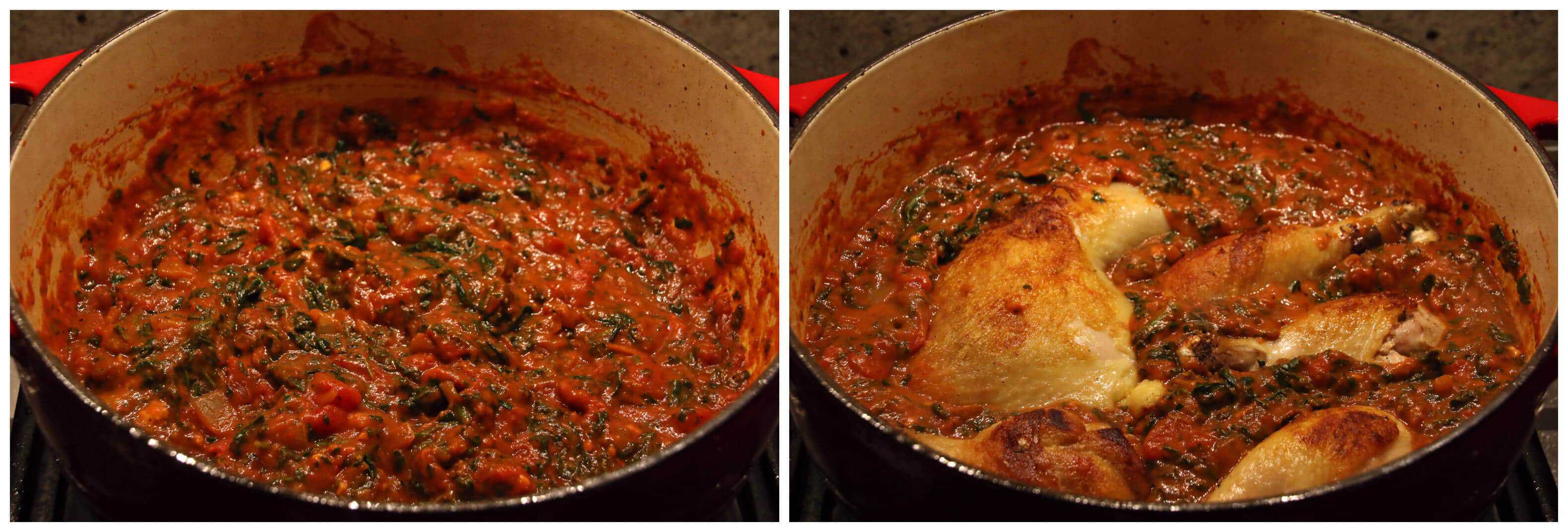
This stew is perfect for leftovers because it tastes even better the next day after the flavors have had time meld.
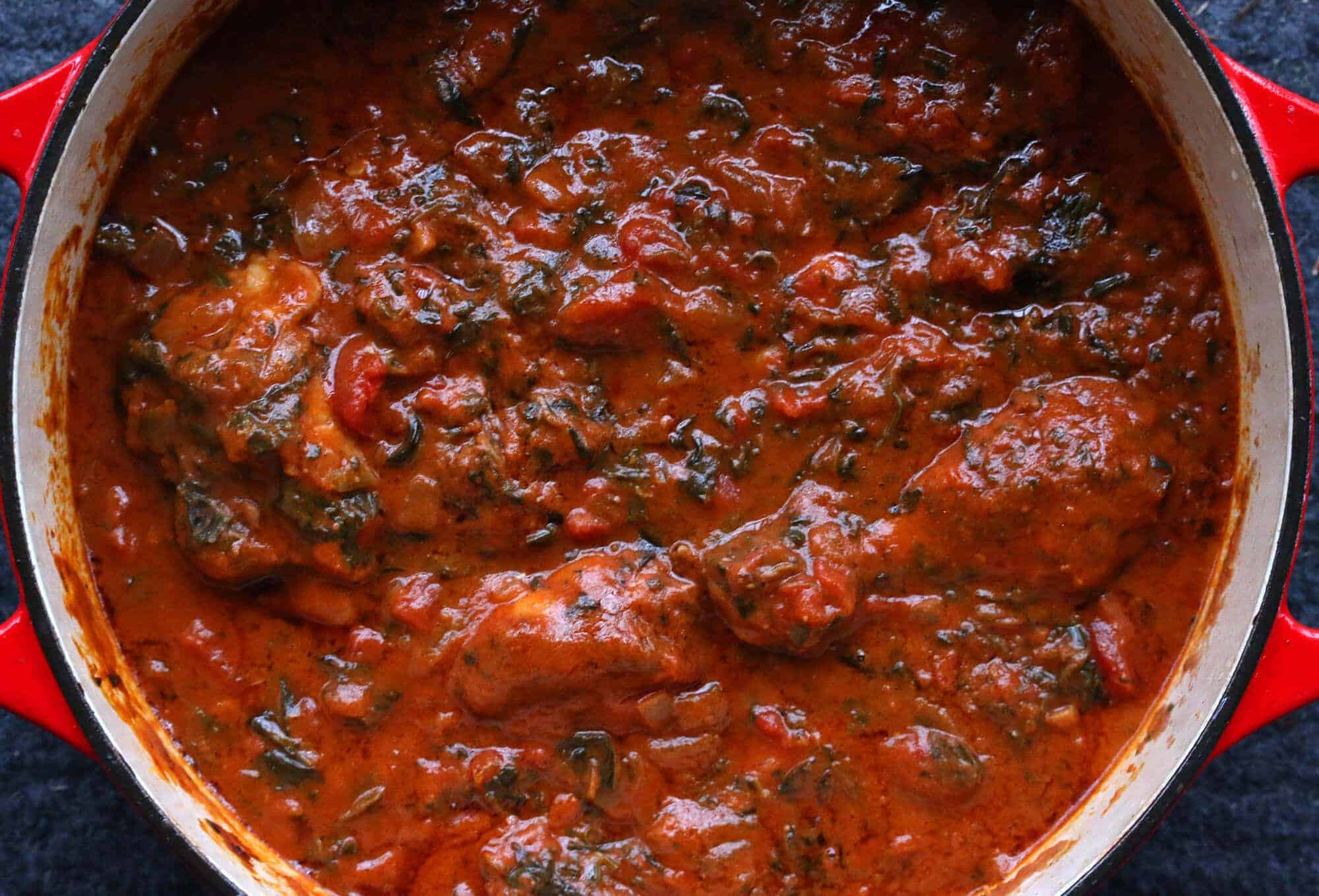
Serve with steamed rice or African fufu (vastly cheaper at your local ethnic food stores) and your choice of vegetables and a leafy green salad.
Enjoy!

For more delicious African dishes be sure to try my:
Save This Recipe
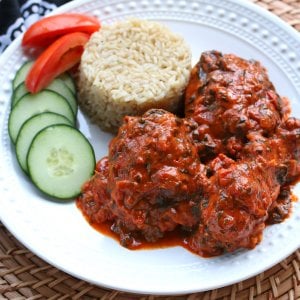
African Chicken Peanut Stew (Plasas)
Ingredients
- 1 1/2-2 pounds bone-in and skin-on chicken pieces (alternatively beef is also commonly used)
- coconut oil for frying
- 1 large yellow onion , chopped
- 28 ounces canned diced tomatoes
- 6 ounce can tomato paste (not tomato sauce)
- 10 ounce package frozen spinach , fully thawed and drained
- 1/3 cup unsweetened peanut butter
- 3 Maggie or Knorr tomato bouillon cubes (a popular ingredient in West African cooking)
- 1 teaspoon salt
- 1/2 teaspoon freshly ground black pepper
- 1 cup chicken broth
- Optional: For some heat add some red chilis or hot sauce
Instructions
- Heat some oil in a heavy pot or Dutch oven until very hot. Generously brown the chicken pieces on all sides (crucial for the flavor of the sauce). Remove the chicken.In the same pot, add some more oil and cook the onions until caramelized. Add the remaining ingredients and bring to a simmer, stirring until the peanut butter is fully incorporated. Return the chicken to the sauce, nestling it in the sauce. Cover and simmer over low for at least one hour. Add salt and pepper to taste.
- Serve with steamed rice or Fufu (see blog post for explanation).Note: This dish tastes even better the next day after the flavors have had more time to meld.



















I worked in Nigeria for 5 years and loved a lot of their national dishes. My two absolute favourites were Pepper Chicken and Dodo and Beans.
Dodo is plantain. I miss these two and a good bottle of Rock beer! Do you have any recipes?
Mike Smyth
Hi Mike, I don’t at the moment but those would both be great additions, thanks for the idea!
i have all the ingredients and am waiting for one of your readers to try it before I do….😊😊😊
Come on ladies….i can only keep uncooked chicken pieces in the fridge for two days.
Must admit it sounds and looks tasty.
Ha! You might just have to be the pioneer in this uncharted territory, Edna :)
Thanks for sharing this recipe! I really enjoy your posting of international cuisine and happy to see a West African dish. A former colleague of mine from Uganda made a chicken dish in a peanut sauce, and I was hooked! Looking forward to making Plasas this weekend!
Hi Edward! Another African peanut-based dish, and the one I make the most, is Domoda from Gambia. It’s one of my husband’s favorites. Here’s the link to that one: http://www.daringgourmet.com/2013/03/02/domoda-gambian-peanut-stew/
Oh boy ! Must try ! Thank you !
This looks lovely but I have never seen tomato bouillon cubes in the UK, is there a good alternative? Thanks.
Hi Emily, traditionally two common seasonings used in West Africa cooking were ogeri and soumbala (a fermented sesame seed product and seeds from the néré tree respectively). But as ogeri has become more pricey and soumbala production has gone done as a result of deforestation, in more recent decades the bouillon cubes have come to replace them for that flavorful umami element. Some West Africans substitute the Maggie cubes for things like seaweed and fermented fish but Maggi is still the staple ingredient in much of their cooking. I lived in England for 7 years and am pretty certain I’ve seen tomato bouillon – if not in cube form then in powder/granules (either Maggie, Knorr, Bisto, etc). Even a packet of tomato soup would work as a substitute, just dump the dry, powdered contents of the soup in this dish. If you can’t find anything tomato-flavored, then go with chicken bouillon cubes/granules and add some tomato paste.
That’s great thank you! I haven’t seen your website before but there’s some wonderful sounding recipes that I am looking forward to trying!
Thanks, Emily, I’m so glad you found us – welcome! :)
Tomato chicken bouillon cubes are found in Mexican grocery stores? Any by you?
I’ve never heard of this dish before! Can’t wait to give it a try!
It looks amazing! I love this kind of international recipes made by people actually coming from a particular country. I have a Syrian friend who cooks for me from time to time, she doesn’t believe in writing down a recipe, if I want to have one from her she has to cook it together with me, so I can see everything she does. The results are always great, she’s one of the best cooks I know.
YUM! I love the sound of that sauce!!